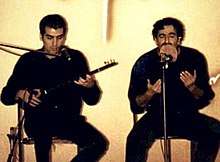Setar
A setar (Persian: سهتار, pronounced [seˈt̪ʰɒːɾ]), also spelled and romanized as setaar or setâr, is an Iranian musical instrument. It is a member of the lute family. It is played with the index finger of the right hand. The range of the setar spans more than two and a half octaves.
 A typical Iranian setar | |
| String instrument | |
|---|---|
| Classification | Plucked |
| Hornbostel–Sachs classification | 321.321 |
| Related instruments | |
| Tambouras, Tar, Tanbur | |
At some point in the 18th century, musicians added a fourth string, which most of the time is tuned to the same pitch as the bass string.
The setar has 25–28 moveable frets. Frets are usually made of animal intestines ("gut"), although in the past strings were made of silk. Some modern commercial models feature frets made of nylon.
The setar originated in Persia before the spread of Islam,[1] and is related to the tanbur. However, in recent centuries, the setar has evolved into something more closely resembling the taar, both in tuning and playing style.
Etymology
The Persian word سهتار setâr is a combination of سه se—meaning "three"—and تار târ—meaning "string", therefore the word gives the meaning of "three-stringed" or "tri-stringed".
Uyghur variant
The Satar (Uyghur: ساتار ; Chinese: 萨塔尔, Sàtǎ'ěr)[lower-alpha 1] is an important instrument in 12 muqam. It is a bowed lute with 13 strings, one raised bowing string and 12 sympathetic strings, tuned to the mode of the muqam or piece being played.
Notable setarists

- Mohammad-Reza Lotfi
- Atâ Jangouk
- Kayhan Kalhor
- Mirza Abdollah
- Sa'id Hormozi
- Yusef Forutan
- Ahmad Ebadi
- Abolhasan Saba
- Dariush Safvat
- Mojtaba Mirzadeh
- Jalal Zolfonun
- Dariush Talai
- Massoud Shaari
- Behdad Babaei
- Hafez Nazeri
- Abdollah Alijani Ardeshir
- Mehdi Aminian

See also
Notes
- The Chinese translation—萨塔尔, sàtǎ'ěr—is a transliteration of the original Persian loanword (via Uyghur).
References
External links
| Wikimedia Commons has media related to Setar. |
.jpg)

